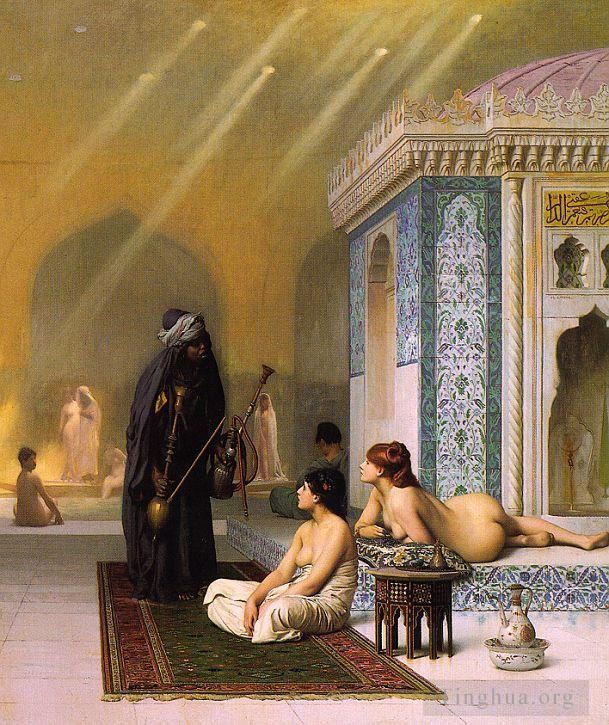Pool in a Harem
Jean-Leon Gerome
- Price: Price on Request
- Art Type: Oil Painting
- Size:
- English Comments: 0
- International Comments: 0
- Creating Date:
- Introduction and Works of Jean-Leon Gerome >>
Work Overview
- Pool in a Harem
Gérôme, Jean-Léon
c. 1876
Oil on canvas
73,5x62 cm
The Hermitage, St. Petersburg
This painting was acquired by the Russian emperor Alexander III at the 1876 Salon in Paris. Prior to acceding to the throne in 1881, Alexander traveled extensively throughout Europe.
Throughout his artistic career Gérome made numerous visits to the Orient - to Egypt, Turkey, Syria, Palestine and Sinai. His unfailing interest in the depiction of scenes from the life of the Muslim world gave him a reputation as an "ethnographic" artist, of which he was very proud. His orientalizing compositions are often of great documentary value. Gérome produced very precise representations not only of exotic costume, architecture and interiors, but also of different ethnic types. In the Hermitage painting we see a Turkish bath in a harem. In the centre, lit through a window in the ceiling, we see two white women and a dark-skinned slave; in the depth, by the pool, are the smaller figures of naked odalisques. With pedantic care Gérome painted the figures and the details of the setting: the smooth surface of the marble floor, the coloured tiles, the furniture and the clothing. The style of Gérome's oriental works, realistic in content and classicizing in technique, is often described as "academic realism".
Pool in a Harem was painted in 1875 by order of the great prince Alexander Alexandrovich (the future emperor Alexander III) and was on display at the 1876 Salon under the name Turkish Women at Bath; later, it was one of the works of art that made up a continuous exhibition of French painting of the 19th century. On March 22nd, 2001, the painting was barbarically ripped from its frame and stolen from the halls of the State Hermitage Museum. In December 2006, it was found in Moscow, and on January 29th, 2007, it was returned to the Hermitage.
The condition of the painting when it was returned was characterized as disastrous. The canvas was crumpled, the fragile fibers of the thin base layer had frayed and suffered friction damage. A cross-shaped perforation had formed along the fold lines, which separated the painting into four parts that were held together by only a few threads.
From 2007 to 2009, this work by the French master underwent a complex process of restoration in the State Hermitage Museum’s Laboratory for Scientific Restoration of Easel Oil Paintings (T.P. Alyoshina, artist-restorer of the highest category, M.V. Shulepova, artist-restorer of the first category).
- Copyright Statement:
All the reproduction of any forms about this work unauthorized by Singing Palette including images, texts and so on will be deemed to be violating the Copyright Laws.
To cite this webpage, please link back here.
- >> English Comments
- >> Chinese Comments
- >> French Comments
- >> German Comments
- >>Report
- Decoration
- La Femme Au Voile
- Bacchante Et LAmour
- Dancing Girl with an Apple
- The Gladiators
- Selene
- Sarah Bernhardt
- Mirmillo
- Sorrow
- Corinth
- Retiarius
- Caesar Crossing the Rubicon
- Corinthe A Seated Female Nude
- Tanagra
- The Ballplayer
- The Harem Bath
- BashiBazouk and his Dog
- Drunken Bacchus and Cupid
- Portrait of a Lady cat167
- The Grief of the Pasha
- A Moorish Bath (Turkish Woman Bathing)
- Woman of Cairo at her Door
- Arnaut blowing Smoke at the Nose of his Dog
- The Call to Prayer
- Head of a Peasant of the Roman Campagna
- Markos Botsaris
- The Death of Caesar
- Dispute DArabes
- Souvenir DAcheres
- Bashi Bazouk singing
- Prayer in the Desert
- Veiled Circassian Lady
- Arab Girl with Waterpipe
- Portrait of a Lady
- Police Verso
- Portrait of a Cactus Collector
- Moorish Bath
- The Cock Fight
- The Negro Master of the Hounds
- Sketch for the Excursion of the Harem
- Napolean and his General Staff in Egypt
- Saber dance engraving
- Tiger on the Watch2
- The age of Augustus the Birth of Christ Greek Arabian
- Portrait of a Lady2
- Excursion of the Harem
- The Carpet Merchant
- Painting Breathes Life into Sculpture
- French 1824to 1904Une Journee Chaud Au Caire Devant2
- Solomons Wall Jerusalem
- Black BashiBazouk
- The Standard Bearer
- Portrait of a Young Boy
- Mufti Reading in His Prayer Stool
- Working in Marble
- A Cafe in Cairo
- Arnaut smoking
- Bathsheba
- The Carpet Merchant Jean Leon Gerome
- Prayer on the Housetops
- Socrates seeking Alcibiades in the House of Aspasia
- Night
- Lion dusk
- The Syrian Shepherd
- Egyptian Recruits crossing the Desert
- The Picador
- Madeleine Juliette Gerome et Ses Poupees
- Lion on rock
- Dante He Hath Seen Well
- Tiger on the Watch 3_2
- Harem Women Feeding Pigeons in a Courtyard
- Anacreon Bacchus and Cupid
- Louis XIV and Moliere
- Cave Canem
- Painting Breathes Life into Sculpture 1893
- Portrait of a Lady3
- Young Greeks at the Mosque
- Lion
- Sculpture Vitam Insufflat Pittura
- Portrait of Mlle Durand
- Cleopatra before Caesar
- Bathers by the Edge of a River
- Pifferari 2
- Diogenes
- Study of a Dog
- Le Jour Du Jugement Dernier
- Treading out the Grain in Egypt
- Quaerens Quem Devoret
- King Candaules
- Self Portrait
- Portrait of a Roman woman
- View of Paestum
- Portrait of Eduoard Delessert
- The Pyrrhic Dance
- The Dance of the Almeh
- The Reception of the Siamese Ambassadors at Fontainebleau
- The Arab and his Steed
- Leaving the Mosque
- The Duel After the Masquerade
- Pygmalion And Galatea
- Waiting for an Audience
- Pifferari cat 196
- Camels at the Fountain
- Napoleon and His General Staff Arabian
- Slave Market
- PersonnageLouis XIII
- Portrait of M Leblond
- The Memnon and Sesostris
- Bisharin Warrior
- Greek Interior sketch
- The Chess Players
- View of Cairo undated
- Arabs crossing the Desert
- A Street Scene in Cairo
- Love the Conqueror
- A Chat by the Fireside
- The Christian Martyrs Last Prayer
- Prayer in the House of an Arnaut Chief
- Pool in a Harem
- The Virgin the Infant Jesus and St John
- Achat DUne Esclave
- Pifferari
- Frederick the Great
- The Duc de La RochefoucauldDoudeauville
- An Arab Caravan outside a Fortified Town Egypt
- The Tulip Folly
- The Plague at Marseilles
- Anacreon 3
- Tiger on the Watch
- Slave Auction
- Interior of a Mosque 1870
- Sais and his Donkey
- Pelt Merchant of Cairo
- Heads of the Rebel Beys
- Egyptian Water Carrier
- BashiBazouk singing
- The Tombe of Hazrat Imam Hisain Allahis Salam
- Un Marchand Darmes Au Caire
- The Last Communion of St Gerome
- Moses on Mount Sinai
- The Muezzins call to prayer
- A Collaboration
- The Colossus of Memnon
- Cairene Horse Dealer
- SNAKE CHARMER
- Femme nue
- The Grey Cardinal
- A Japanese imploring a Divinity
- Harem in the Kiosk
- Prayer in the Mosque
- Pho Xai
- Study Age of Augustus Birth of Christ Greek Arabian
- Arnauts of Cairo at the Gate of BabelNasr Greek Arabian
- The Bacchante
- The Republic
- Summer Afternoon on a Lake
- Phryne before the Areopagus
- Prayer in the Mosque
- Michelangelo
- Whirling Dervishes
- Julius Caesar and Staff
- Recreation in a Russian Camp
- An Arab and his Dog
- View Of Cairo









 Singing Palette
Singing Palette